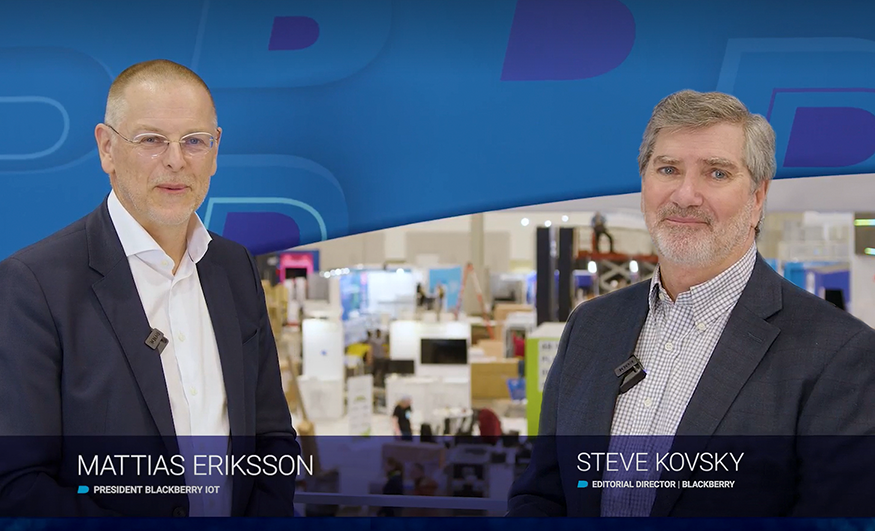Get In: The Software Defined Vehicle Podcast from BlackBerry (Season 2, Episode 1)

Cars are transforming into intelligent edge devices. They have an increasing level of computational power, and now bristle with sensors of every description, from cameras to radar to ultrasonics. All this digital technology is being harnessed to provide sophisticated new features for safety, convenience, and entertainment. But these capabilities need a dependable software platform to provide the reliability and security that automotive applications require.
Welcome to Season 2 of “Get In: The Software-Defined Vehicle Podcast from BlackBerry.” This video podcast series explores the possibilities created by — and technologies behind — the revolution in global transportation we are witnessing today with software-defined vehicles. In this first episode of Season 2, we visit the Consumer Electronics Show 2023 in Las Vegas to meet Mattias Eriksson, president of BlackBerry Technology Solutions. In this in-depth interview, he explains how BlackBerry’s innovations are helping build a solid basis for innovation at the automotive intelligent edge.
Watch the full Season 2, Episode 1 podcast (below):
“We are showcasing what we have done over the last 12 months since the previous CES, and what is on the roadmap for the next 12 to 24 months,” says Eriksson. “We’re also doing something new this year. We have collaborated with MotorTrend to present an automotive award for software.
“At our CES booth, we have the two major components that are the backbone of what we're doing. One is the evolution of QNX, our core software development platform. The second one is the evolution of IVY, our partnership with AWS for edge processing of sensor data."
These two platforms are key to BlackBerry’s efforts to fuel the current trends in the automotive software sector. “We are showing two major changes with QNX,” says Eriksson. “First, we have put QNX in the cloud, together with AWS. There are lots of very important implications from that. Second, we are introducing the next-generation microkernel in 2023, which is something that we have been working on for the last three and a half years. A new microkernel doesn't happen that often — every 10 years or so. It’s a very important development for high-performance compute at the edge, and some of that is reflected in IVY too.
“We talked quite a lot about IVY at CES last year,” continues Eriksson. “We did an incredible amount of work on IVY since then, both on the roadmap and on the proof of concept, to make sure that the platform is hardened. We are showcasing IVY on three commercial automotive grade platforms.”
These include: Bosch’s platform, providing a predictive maintenance system powered by Compredict and secure in-vehicle payments powered by CarIQ; PATEO’s intelligent digital cockpit, incorporating EV battery management; and the BlackBerry IVY™ integration with AWS, demonstrating how automakers can rapidly develop machine learning-based solutions for scene detection and cybersecurity.
“We have a very particular architecture that has tremendous benefits for our customers,” explains Eriksson. “The microkernel architecture is, from our perspective, the most secure, the most stable, and the most high-performance kernel for real-time operating systems out there. We are evolving that kernel to make sure that we can respond to the customer requirements for high performance at the edge. We are now in early access for this next-generation kernel. It will manage multi-core edge compute, which is extremely important, and we are convinced it's going to be the most efficient and highest performing microkernel in the world.
“The QNX software platform reduces complexity for our customers when building sophisticated, intelligent edge IoT stacks,” says Eriksson. “You need a solid foundation for that stack and QNX is the ideal choice for most customers. It also reduces time-to-market.” This is because it relieves automotive vendors from having to perform low-level software development themselves. “You can focus your software engineers — and the valuable investment you have in software — on the application layer and the things that really matter to differentiate yourselves with your customers,” adds Eriksson.
“At the highest level, we differentiate ourselves across four dimensions: We talk about performance. We talk about safety. We talk about security. We talk about reliability. There's a lot to say about each of those four, but these are how we differentiate QNX.
“The major trends in edge compute are pushing requirements in the direction of our value proposition, so more customers doing things with edge IoT can make use of features like Unity.” This is the touch-enabled graphical interface supported by the QNX® platform, which is also popular with game designers. “That wasn’t the case five years ago, but because automotive platforms have more compute, more sensors, more connectivity, and high requirements for security and performance at the edge, suddenly QNX is a viable foundation for that sophisticated stack.”
Alongside revealing the latest developments in QNX and IVY™ at CES 2023, BlackBerry also partnered with MotorTrend to present the inaugural Software-Defined Vehicle Innovator Awards. “We're doing this because we believe that there is a lot going on in the automotive industry in software,” says Eriksson. “But outside of the small sphere of the automotive business, people are just not aware of that — and they should be, because from our perspective, there is no more interesting or more challenging place to do software work.
“In automotive we now talk about the next-generation software-defined core as the most advanced IoT edge point,” explains Eriksson. “There's no other edge point that has more compute power, more sensors, more connectivity, or more cloud interaction. Solving the problems in the software stack that is driving that evolution is, from our perspective, the most exciting software challenge there is right now. If you're going to solve very difficult problems like this for many years to come, you need good people.
“There are some incredible people working on automotive software at present and this award is about celebrating some of their achievements,” continues Eriksson. “We look at the innovators, the pioneers, and the leaders and we try to shine a light from our small standpoint in the industry on all the great things that are going on in the background. Obviously, there is a little bit of an ulterior motive. We believe that the automotive industry as a whole requires many more excellent software engineers. It's a problem for everybody, including us, to find these people. We would much rather have the best graduates from the best schools coming to work on these incredibly exciting problems, rather than tweaking advertising algorithms for TikTok.
“If you're working on an advanced software edge compute stack today, talk to us,” exhorts Eriksson. “We have an incredible roadmap and an incredible portfolio — the strongest it's ever been. We are investing at a very high rate into the future of this edge compute stack. And we are working with some of the brightest stars in this space at present. We are convinced we can help you, so talk to us!”
Listen to Season 2, Episode 1 of “Get In: The Software-Defined Vehicle Podcast From BlackBerry.”
For similar articles and news delivered straight to your inbox, please subscribe to the BlackBerry Blog.
Related Reading
- Get In: The Software-Defined Vehicle Podcast From BlackBerry (S1E1) How AWS is Enabling the New Era of Automotive Digital Experiences
- Get In: The Connected Vehicle Podcast From BlackBerry (S1E2) How Car IQ Is Turning Autos Into Auto-Payment Vehicles
- Get In: The Connected Vehicle Podcast From BlackBerry (S1E6) Smarter Cars with BlackBerry IVY™
- Look Back at CES 2023: Not Your Father's Consumer Electronics Show
- BlackBerry and MotorTrend Honor Winners of First Software-Defined Vehicle Innovator Awards
